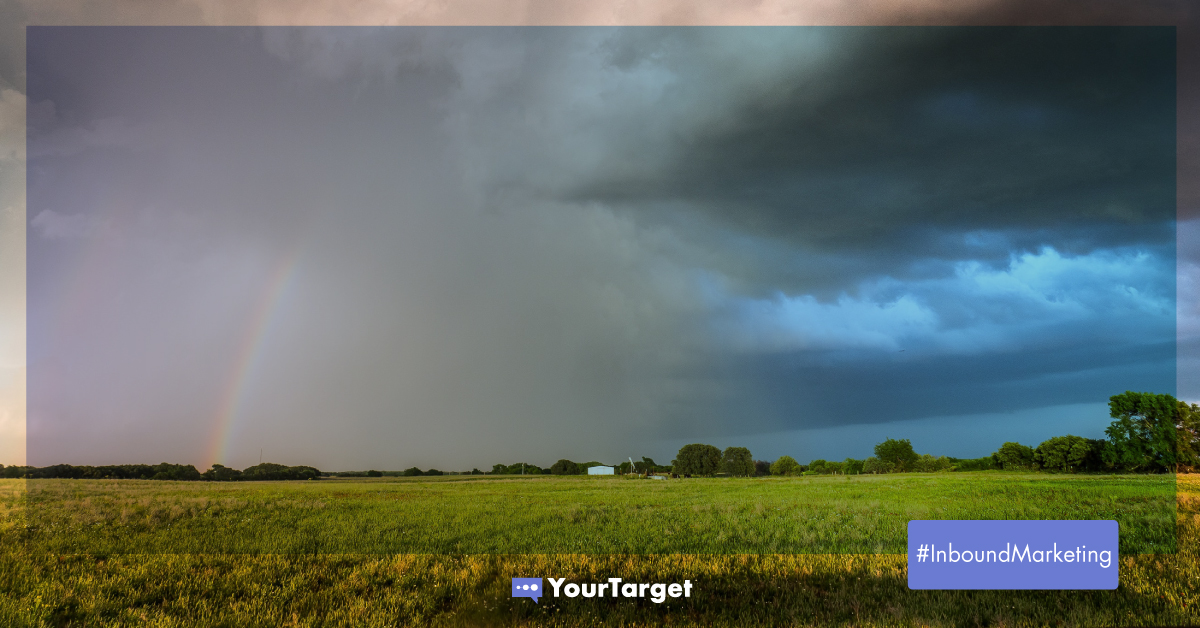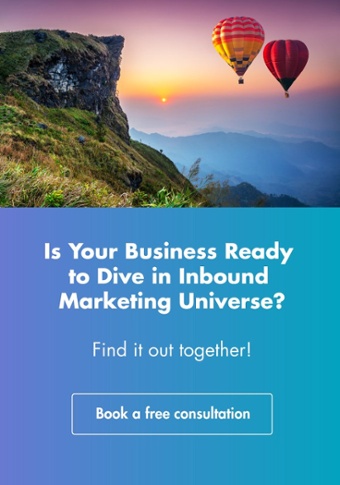Marketing jargon can be pretty confusing (for marketers, too!) The inbound-outbound marketing dichotomy can be difficult for business owners to wrap their heads around. If, at some point in your life, you’ve found yourself wondering “what’s the difference between inbound and outbound marketing?” then rest assured that after reading this article you’ll be the expert! Let’s dive right in!
What’s inbound marketing?
Inbound marketing is a concept that’s relatively new in the marketing scene. It aims to draw customers into your brand organically and attract prospects who are actively looking for products or services online.
It’s a strategic approach where brands use a combination of tailored content and experiences to attract, engage, and delight prospects and customers (read: Hubspot’s Flywheel philosophy) to keep them moving through the inbound marketing funnel.
Some of the key features of inbound marketing are:
- Draws interested people in
- Solves customer needs and addresses their pain points
- Grows your business by building lasting relationships with consumers, prospects, and customers
- Businesses create and distribute valuable content
- Seen in websites, blogs, eBooks, opt-in emails, SERP, social media
How does Inbound Marketing Work?
So how does it work? It works by drawing customers in with valuable content that’s targeted, personalized, and meets them where they are in their customer journey. It focuses on building trust with a target audience by providing informative or entertaining content.
Inbound marketing works because it attracts the right kind of traffic to your brand at the right time. This quote sums it up pretty succinctly:
“Inbound Marketing is so powerful because you have the power to give the searcher/consumer exactly what answers they are looking for at the precise point that they need it. That builds trust, reputation, and authority in whatever niche you are practicing this form of marketing in.”
-Joshua Gill, Inbound & SEO Marketing Consultant, Inbound Authority
What about outbound marketing?
Until inbound came and stole the limelight outbound marketing used to be just “marketing”.
Outbound marketing can be described as interruptive, as it pushes itself towards an audience whether they’re interested in it or not. Some examples of outbound marketing include ads on TV and radio, telemarketing, billboards, newspaper and magazine ads, cold calling, pop-ups, etc.
Think about when you’re relaxing after a long day at work, tuning into your favorite TV show. You’re enjoying an episode, you’re in the flow, when suddenly – the stream of entertainment is rudely interrupted and you’re forced to watch 5 minutes of commercials where people excitedly talk about cleaning products, cars, and a myriad of other things. That’s outbound marketing.
The key features of outbound marketing include:
- Pushes messages towards everyone, regardless of whether they’re interested in a product or service
- Written to sell products
- One-way communication method
- Disruptive
- Found in: TV ads, billboards, pop-ups, cold-calling, etc.
Outbound vs inbound: which is more effective?
When it comes to determining which marketing method is more effective, we need to look to the contexts in which they’re used.
Traditional methods of marketing used to work well. Outbound marketing was novel, captivating, and exciting. However, tactics that once captured the attention of audiences and led them to make a purchase decision have lost their effectiveness over time.
Today, consumers find outbound marketing strategies too disruptive, invasive, or just super annoying. When was the last time you decided to buy a product after seeing it advertised on a billboard? We’re betting your answer is either “a long time ago” or “never”.

Marketing in a digital world
Inbound marketing strategies like blogging, SEO, and social media are much more suited to modern consumers who increasingly turn to digital platforms to find information, communicate, and shop. With this in mind, we can better understand the reasons why 70% of people prefer learning about a company through content than advertising.
Don’t get us wrong, we’re not denying that outbound marketing tactics still have a certain role to play in today’s digital world. Outbound methods continue to promote brand awareness, but only 18% of marketers believe that outbound practices generate high-quality leads, compared to 60% for inbound strategies. Moreover, studies have found well-executed inbound marketing to be 10x more effective at generating leads than outbound.
So to answer our question, we’re going to bite the bullet and say inbound marketing is much more effective than outbound in today’s world.
Modern customer’s don’t want to be sold traditionally, they want to engage and build relationships with the businesses they interact with. For this reason, organizations can benefit from the inbound methodology which prioritizes lead nurturing, building trust, and entering into long-lasting, two-way relationships with customers.
How to transform from outbound to inbound
If you’re still relying solely on outbound marketing tactics to boost sales and achieve business results, then you’re living in the past, my friend.
If you’re already using a combination of both practices then you’re on the right track. If not, it’s time to leverage the power of inbound marketing to meet your goals and reach your full business potential.
Bridging the digital gap between your business and your customers isn’t simple, but it’s not too difficult either. With the right tools and an informed approach, adopting an effective inbound marketing strategy is an achievable goal for any business.
We’d like to share 3 best practices that you should use to inform your inbound strategy.
3 inbound marketing best practices
1. Get to know your audience
Understanding your audience is a concept that lies at the heart of inbound marketing. Businesses need to make an effort to get to know their audience to ensure their marketing efforts are addressing particular pain points, preferences, and motivations.
So how do you get to know an audience that you’ll probably never meet (in person, anyway)?
To develop a solid idea of who your customers are, you’ll need to find your audience with buyer personas. These are semi-fictional representations of your target customer(s), and they’re defined by factors like:
- Demographic information (age, gender, race, income, education, etc.)
- Pain points and challenges (that your business can address)
- Goals and motivations (why they’re searching)
- How they prefer to communicate
Once you have an understanding of the people in your target audience, you can use this information to inform your inbound strategy by delivering personalized content and customer experience. This enables you to build mutual, long-lasting relationships with your customers.

2. Build your website to drive sales
An effective website can make or break your business.
We live in a digital revolution where consumers expect websites to be intuitive, easy to navigate, and optimized for any device they so choose. It’s not just about providing a good customer experience, a poorly designed website can lead to lost credibility and reduced sales.
It takes website visitors just 0.05 seconds to decide whether they like a website or not. What’s more 85% of adults today agree that a business’s website when viewed with a mobile device should be just as good, if not better, than when viewed on a desktop.
With these statistics in mind, businesses must ensure their website:
- Is designed with the user in mind
- Is aligned with their brand message
- Incorporates SEO best practices to attract more traffic
- Features a responsive web design that adjusts to mobile, tablet, and other devices
- Is optimized for voice search
With 88% of consumers unlikely to return to a website after a single bad experience, businesses must make a good first impression.
3. Develop a value-driven, relevant content strategy
Content lies at the core of inbound marketing. A great inbound strategy needs to deliver content that’s valuable, relevant and speaks to the customer at various stages of the funnel.
Today, 70% of marketers are investing their time and resources in a content strategy. As we mentioned before, you’ll need to know your audience and use measurable KPIs to ensure you’re generating highly targeted, personal content that’ll provide value and build the brand-customer relationship.
Content can take the form of:
- Blogs
- Social media posts
- Video content (the most popular format in 2020)
- Infographics
- E-books
- Podcasts
- White papers
- Landing pages and CTAs
- Email marketing
Consumers are increasingly turning to the internet to find answers to their problems and questions. Let’s face it, most people nowadays are attached at the arm to their mobile phones and laptops. Businesses need to keep up and adjust their marketing strategies to cater to a digital audience.
Sharing valuable content with your audience allows you to build trust, boost sales, and enhance customer retention rates. Use an editorial calendar to structure your content strategy, to ensure it’s always timely and relevant.
With digital trends and shifts in consumer behavior occurring rapidly, marketers need to ensure they’re completely clued-up on the latest strategies to ensure they achieve their business goals and keep customers happy and loyal.
In today’s digitally-driven world, traditional outbound methods aren’t as effective as they used to be. Inbound marketing is the way forward. Businesses need to ensure they’re incorporating effective inbound strategies that provide customers with value beyond the transactional.
Are you ready to boost your business with an inbound marketing strategy?
We consider ourselves inbound experts, so get in touch and book a free consultation today.

